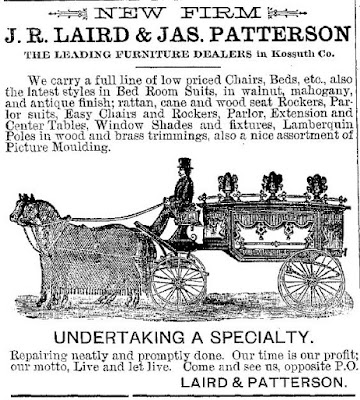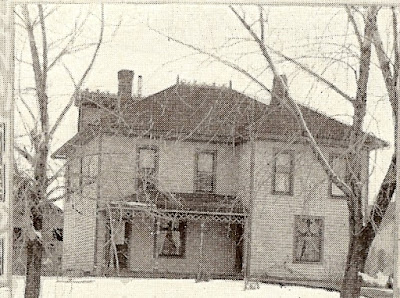One
of my favorite parts of researching the homes featured in the book “Picturesque Algona” is learning the
histories of houses that I have passed a million times and taken for granted. Such is the one showcased today located at
703 East Call Street.
THE J. R. LAIRD HOUSE
Identified
as the J. R. Laird home in “Picturesque
Algona,” the house was actually built by C. E. Hyde. Mr. Hyde was the owner of a cooper shop. His specialty was manufacturing butter tubs,
but he also built barrels and firkins (casks or vats). In 1880 he acquired a group of adjoining
lots. The following year he built the
house now standing at this location. A
conservatory was added on the south side of the house seven years later.
That
was the same year that James R. Laird moved to Algona. Born in Carroll County, Indiana, in 1843, his
family moved to Dubuque when he was two years of age. They later moved to Jones County. His father passed away when James was 13,
leaving the young boy to help support his family. He worked as a farm hand until 1863, when he
enlisted in Company C of the Twelfth Ohio Cavalry. He fought to the end of the war. Although never wounded in battle, Laird
suffered from typhoid fever, dysentery, and rheumatism while in service. Following the war, he eventually settled in
Marshalltown where he operated a furniture business until he came to Algona
when he acquired the Bronson furniture business located on State Street.
Mr.
Laird had been married in 1878 to Alice Fowler who died two years later. They had no children. He then married Ella Launsbery on September
16, 1882. They had several young tots
when they moved to Algona and their family would grow to five children within a
few years. In 1890 they moved into the
Hyde house but soon realized they would need more room. The Lairds built an addition to the top of the
house in order to make more room upstairs.
The roof was raised about six feet.
When completed, there were five rooms on the lower floor and five rooms
and a bath upstairs. That was how the
house looked in 1900 when “Picturesque
Algona” was printed.
Further
improvements were made in later years.
In 1901 the house was raised and a stone foundation was placed under
it. The next year stone walks were
added. Because Laird owned several
adjoining lots, he built a large barn behind his new home shortly after
purchase. It is always hard for me to
picture how the property would have looked at the time because I am so used to
the neighborhood as it now appears.
However, in the late 19th century and early 20th
century, it was not uncommon for homes in town to have their own barns to keep
not only a cow for milk, but also their trusty horses, a buggy and/or sleigh, or
other large items used on a regular basis.
THE LAIRD FURNITURE STORE
In
his early days in Algona, J.R. had two partners in his firm. The first was James Patterson, a local man
looking for a business to suit his talents.
The partnership itself was brief and another young man, W. L. Dingley,
took his place. That affiliation was
also short lived. Mr. Laird operated on
his own until he hired his nephew, Warren Laird, to take over the undertaking
business some years later.
The
Laird store was on State Street and was two stories in height. The furniture department was on the ground
floor and carried almost every piece of furniture you can imagine. From upholstered chairs and bedroom sets to
dining room and kitchen tables, he carried all furniture needed to fully outfit
a home. In addition, he carried all the
necessary furnishings—pillows, decorative accessories and framed pictures—even
baby cabs, hobby horses and coaster wagons!
His frequent ads proclaimed the superiority of his goods. The advertisement published in the Algona Advance on November 22, 1906, however,
had a more negative tone—most likely aimed as his competition. It contained the following poem:
The
shades of night were falling fast,
As to
our store there quickly past,
A man
who mattresses desired to price,
But as
to kind, replies ‘gainst all advice,
“Excelsior”
Try not
that kind, we quickly said,
We’ve
others, better for your bed.
A cotton-felt
you’ve never tried.
But
stern and loud his voice replied,
“Excelsior”
Beware
of cheap mattresses as you’ve been taught,
Beware
of what you think you’ve bought,
This
followed him our last goodnight,
He
answered, passing from our sight
“Excelsior”
When
but a week had passed away,
Dying,
he on that mattress lay,
No
other would he have to ease his pain,
And
with his last breathe faintly said again
“Excelsior”
Do
you get the impression that Mr. Laird did not think much of the Excelsior
mattress?
In
addition to operating the furniture store, Laird also served as the local
undertaker. It was quite common at that
time for a furniture business to be combined with an undertaking establishment. Stocking coffins along with furniture most
likely made a lot of common sense.
 |
| Published in the Algona Republican June 13, 1888 |
The
second floor of the business was dedicated to the undertaking department. Here the embalming was performed as well as
other pre-burial needs met. Mr. Laird
had a very striking hearse which originally cost over $1,100. He traveled the county assisting families as
their needs arose and was often called to the scene of accidents to transport
bodies. Laird also provided funeral
services for the indigent, being reimbursed by the county for his costs.
 |
| The Laird Hearse |
COMMUNITY INVOLVEMENT
The
Lairds were involved in their church, the Congregational, as well as many other
area organizations. Like many Civil War
veterans, J.R. found much comfort in his participation in the local James C.
Taylor post of the Grand Army of the Republic.
He served in many officer positions including commander. Mrs. Laird honored her husband’s service by
her activity in the area chapter of the Women’s Relief Corps. She served as president for a period and often
traveled to the state convention representing her group.
On
several occasions, J.R. was elected a state representative to the national
encampment of the G.A.R. He would travel
with other local veterans such as Dr. H.C. McCoy and Lem Stockwell to places
like Cincinnati and Philadelphia where they would participate in meetings,
parades and other memorial celebrations.
His support of the local veterans was so well thought of that he was
appointed by the Kossuth County board of supervisors to serve as a member of
the soldier’s relief commission.
THE END COMES
The
old illnesses that had attacked him during his service to our country continued
to plague him the rest of his life and by 1900, he was encountering some
difficulties. He was awarded a veteran’s
pension at that time, but continued to operate his business until the spring of
1913 when he sold out. He died the following November in the home
where he and his wife had raised their beloved family.
Ella
Laird had no choice but to carry on. Her
youngest child was only 18 years of age when his father died and he would soon
find himself engaged in World War I. Clare
Laird became a pilot and flew many missions over France.
Mrs.
Laird remained in the family home the rest of her life. Her 14 grandchildren helped to keep it a busy
place and she enjoyed their visits immensely.
She lived to the ripe old age of 90 and was able to enjoy the comforts
of her own home until the end with help of her daughter, Ethel Chubb, who
resided with her during the last years.
The
house continues to stand in faithful tribute to those who have lived and loved
inside its walls.
Until
next time,
Jean
If you enjoyed this
post, please don’t forget to “like” and SHARE to Facebook. Not a Facebook
user? Sign up with your email address in the box on the right to have
each post sent directly to you.
Be sure to visit the
KCHB Facebook page for more interesting info about the history of Kossuth
County, Iowa.
Reminder: The posts on Kossuth County History Buff are ©2015-16 by
Jean Kramer. Please use the FB “share” feature instead of
cutting/pasting.


No comments:
Post a Comment